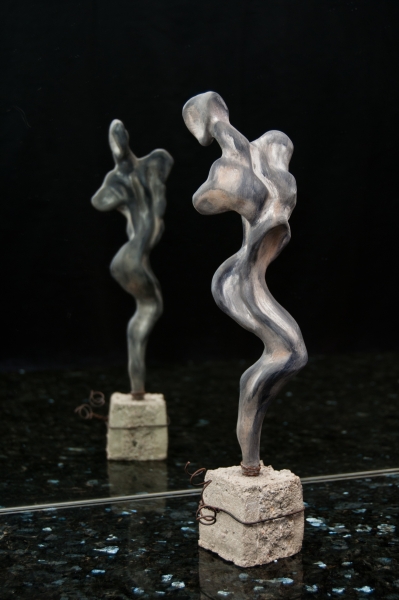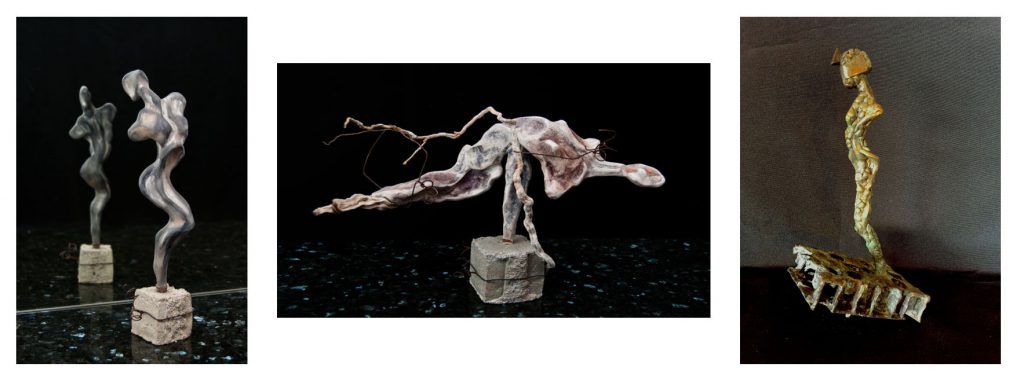Curricular tie:
Big ideas:
-Growth as an artist is dependent on perseverance, resilience, and reflection.
-Artistic expression is an artist’s physical, emotional, and cognitive articulation of our humanity.Explore and create:
-Create three-dimensional (3D) artistic works using sensory inspiration, imagination, and inquiry • Explore artistic possibilities and take creative risks • Intentionally select and combine materials, processes, and technologies to convey ideas
First Peoples Learning Principals:
–Learning requires exploration of one‘s identity.
–Learning is embedded in memory, history, and story.
Intro
I have heard it said, although there is no way to be sure, that Sculpture was the first of the visual arts.
Sculpture the act of representing something, even if it’s nothing, through 3D materials. Either additive, subtractive, or both. Sculptures fall into four basic categories: moulded, cast, carved or assembled. (wikipedia)
The oldest figurative sculptures we have are categorized as Venus Figurines, as they are understood as earth goddesses or fertility figures found in the Upper Paleolithic period circa 10,-50,000BCE. Not many Male figures have been found from this period. Venus of Hohle Fels dated circa 35,000BCE. It was Carved from Mammoth tooth Ivery.

Image source Wikipedia
Another of these Venus figurines is the Venus Wilendorf, found in Austria. It was carved from stone. It dates somewhere between 25-28,000 BCEd.

Image source Wikipedia
The first Ceramic Human fig seems to be the Venus of Dolní Věstonice, found in what is know the Chezc republic It dates to somewhere between 25-29,000 BCE.

Image source Wikipedia
Here is the Goddess of Catal Huyuk.
A Terracotta sculpture from around 6,000 BCE. Made from Terracotta. Found in Asia Minor – Anatolian Civilizations.

Image source http://www.visual-arts-cork.com
For me, there is a beautiful quality of ‘human-ness’ in these Venus Figurines. We know they are of the human forms, but they speak to us on a different level, an emotional or a phycological plane. After all, we can relate to them as fertility gods, mothers, women, givers of life. There is something special about Venus figurines.
Are they Beautiful? Who amongst us as a small child didn’t look up to their mum and think that they were that they were beautiful… of course we did… at one time they were our whole world
But you are now teenagers on your way to being young adults and you have begun to experience the world and and all the stressors, pressures, confusion, political struggles, hypocrisies, and opportunities that suround you. And these realities of everyday life can push and pull you both physically and mentally.
For this project I want us to take it as a learning and playful experience to build our understanding of ‘How’ we can use clay and other materials to produce a sculpture which holds meaning. Meaning which can be interpratated through form and material
Take an emotion, personal issue or political event that you know, that you have REALLY known. Now sketch it- do your best to get the vibe, the proportion is nice but not the most important thing. If you can write a paragraph, or more, about it.
How can you use clay and/or different materials to help convay your ideas to your audience?
This does not have to be a Clay project, you are welcome and encouraged to think about how different materials hold different attributes, feel. looks, vibes…. etc
This bronze sculpture Shadow Spirit, Julia S. Rasor

Image sourcehttp://www.fineartsculpt.com JS. Rasor
And Departed, also by Julia S. Rasor, are a good place to begin…

Image source Rasorssculptures.com JS. Rasor
And, Transforming Spirit, Julia S. Rasor

Image source http://www.fineartsculpt.com JS. Rasor
For me, there is a beautiful quality of ‘human-ness’. We know they are of the human forms but they speak to us on a different level, an emotional or a phycological plane.
Question: What does this work do to you? How do they make you feel and what do they make you think? (Answer in your sketchbook)

Okay, now let’s take a look at some more artists.

Image source ww.xavierhufkens.com A. Gormley
The works of Antony Gormley also present us with human quality in a way that we have to think beyond what we usually do when we see someone walking down the halls.

Image source www.xavierhufkens.com A. Gormly

Image source http://iloboyou.com/ XA Choi
Here are more images by various artists:

Image source www.metmuseum.org Jean-Baptiste Carpeaux

Image source www.metmuseum.org A. Rodin Nudes

Image source jamesrottmanfineart.com Sorel Etrog

Image source odonwagnergallery.com/ S. Etrog

Image source https://pikstagram.com H Lanino

Image source https://hyperallergic.com D Youngblood

Image source https://hyperallergic.com D Youngblood

Image source https://hyperallergic.com D Youngblood

https://contemporarynativeartists.tumblr.com/ . Rose Bean Simpson

https://contemporarynativeartists.tumblr.com/ . Rose Bean Simpson

Image source http://iloboyou.com/ XA Choi
And I have to say, this next Artist Yoshitoshi Kanemaki from Japan is doing some AMAZING WORK!!! Take a look.

Image source thedesigndome.com

Image source thedesigndome.com

Image source thedesigndome.com
AND! here is another treat! The work of the Spanish sculptor Isabel Miramontes,

Image source mymodernmet.com

Image source mymodernmet.com

Image source mymodernmet.com

Image source mymodernmet.com
Assignment:
Take an emotion you know that you have REALLY known- Anger, Fear, Anxiety, Joy etc. In privet find a dynamic body position that echos your memories of those feelings. Now sketch it- do your best to get the vibe, the proportion is nice but not the most important thing. If you can write a paragraph, or more, about it. (Breath) …You don’t have to show it to me if you don’t want to… But the activity itself is helpful to connect, reflect and hopefully learn/reveal something new, about the emotion or event,
Question: What does this work do to you? How do they make you feel and what do they make you think? (Answer in your sketchbook)
Project Criteria:
- One clay sculpture rooted in memory, or put another way, (that comes out of your, from a time in your life when you felt an emotion or a sonorous, or deeply resounding, level. It doesn’t have to be ‘pretty’… it doesn’t have to be in proportion… it has to be real.
- One page of small sketches
- one 4×7″ draft
- Exit paragraph on the meaning of your work
Websites that may interest you on stone age sculpture:
More about Venus Figs (even a few male VF’s!)
Sculpture History (Uni of Cork)
The Bradshaw Foundation. prehistory
All You Need to Know about Stone Sculpture
